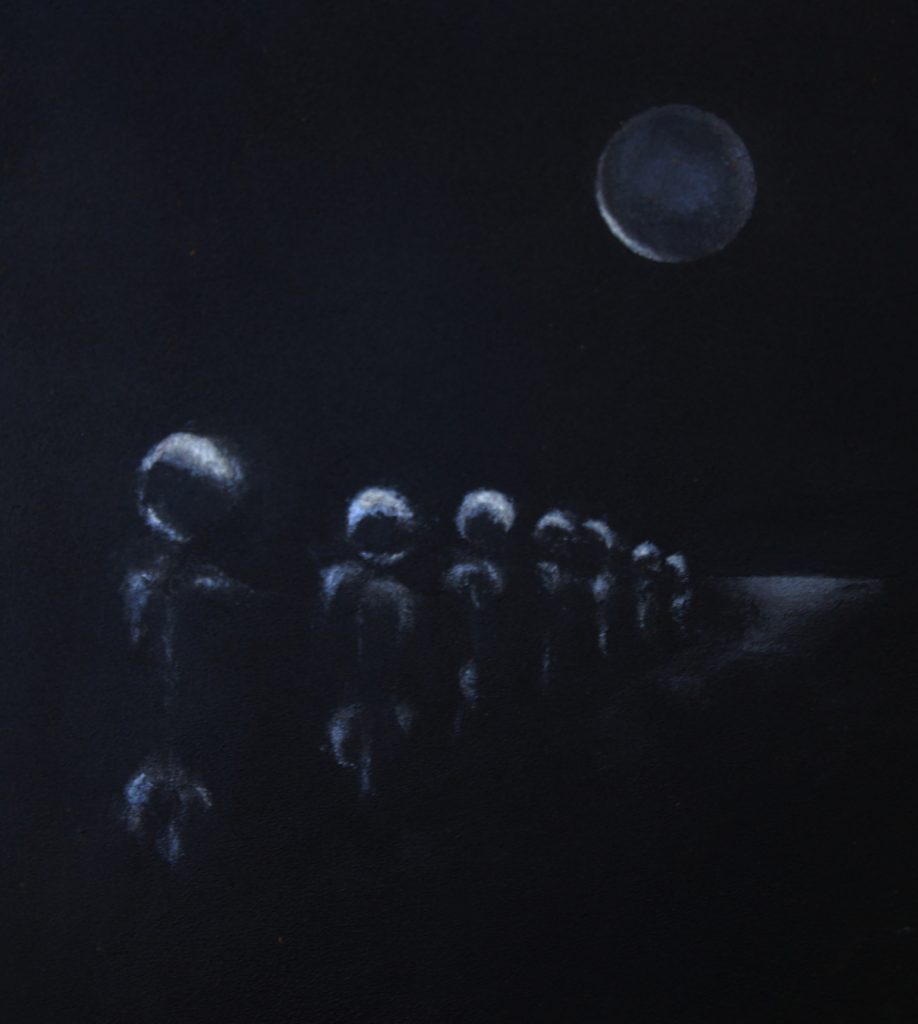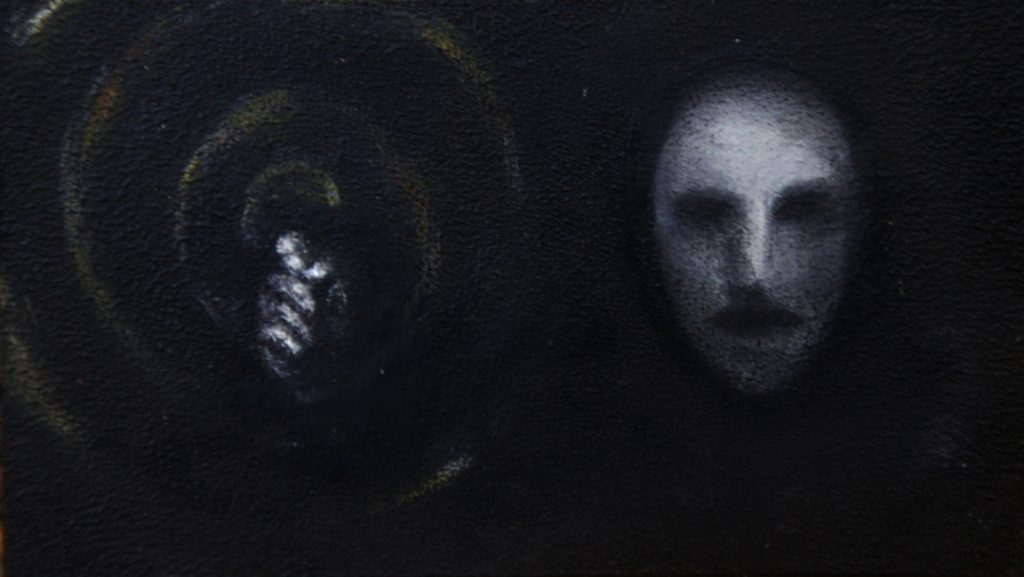Charl-Christo Petersen’s paintings from Day 143 of lockdown.
While we all have our own lockdown stories to tell, Cape Town fine artist Charl-Christo Petersen’s narrative is a painted one. Lockdown had many of us vegetating in a dull existential crisis, but Petersen did a painting a day to survive lockdown. That’s 165 paintings in 165 days.
When the initial announcement of 21 days at home was made, his workplace closed and he used the money from his last shift as a barman to buy 21 canvas panels. Like many of us, he had lost his income, but needed a reason to get up every day. He planned to paint one painting every day for what he expected to be a 21-day lockdown. When lockdown was extended, he ended up with 165 reasons to get up.
Petersen’s collection was painted daily during the South African lockdown, from 21 March until 7 September 2020. In November 2020, all 165 pieces were exhibited at Youngblood Art and Culture Development in Cape Town in the exhibition: Mirror-19: a reflection of Covid-19 lockdown — 165 days 165 paintings.
Living on his own, the lockdown days were long and Petersen was inspired by inner conversations and battles. During these 165 days, his style has seen immense growth and changed at a rapid pace, as he learned to trust his subconscious to direct his art.
Petersen left the corporate world to focus on his art in 2017. Based in Observatory Cape Town, he studied interior design and has worked in various media, including stainless steel furniture, charcoal and street painting using stencils at events like the Cape Town Design Capital, Open Streets Cape Town and Streetopia. Over time, he has transferred his style and technique from street onto canvas.
Mia Arderne: How did doing a painting a day help you to survive lockdown? On Day 150 you posted, “still a reason to get up every day” — tell us about the impact a painting a day had on your mental health during this time.
Charl-Christo Petersen: I think by Day 150 it may have become an obsession. Or became my duty to do so. At this stage I was still quite determined to complete till the end of lockdown. If I didn’t, I would be a failure.
There was nothing else for me to do. I could not go to work; I had no income and was relying on family and friends for support. But I decided that that is not a healthy approach and there is more to life, myself and who I am. The painting did get me up every day. I could easily have stayed in bed through the lonely and depression stages and watched movies or series all the time, but I had one thing to get up for, go shower, and that I had to complete before I could relax. And that was to complete my painting for that day.
What themes do you explore in your art?
My thoughts and ideas. I try to capture one of those moments or ideas in an image. Day 97 is a good example. I tried to make sense and explain my thoughts and feelings at the sight of the queues of people with masks, going in and out of their homes just for essentials. It felt very surreal and almost like being part of a machine that day I went to the shop. That’s how the image of a queue of people climbing into my head through my ears to my eyes came about.
 Charl-Christo Petersen’s painting from Day 157 of lockdown.
Charl-Christo Petersen’s painting from Day 157 of lockdown.
How have you grown through this process? Tell us your story behind the progression of these paintings.
I have painted the streets all over Cape Town; some can still be seen if you use satellite view on Google Maps. I have created stainless steel functional art pieces, one which even became a finalist in a national competition, yet … I have never been comfortable calling myself an artist.
I can say it was the romance, loneliness, loss of friends, the support I received; the inner battles that one has to face, the insecurities, doubts, paranoia and panic that I dealt with day in and day out for 165 days — bringing them out and to the surface in a creative way on a canvas is what grew into the artist I now comfortably call myself.
Tell us about your Young Blood First Thursday exhibition: What was it like seeing your lockdown work displayed?
It didn’t quite feel real. I think I was more focused and concerned about how people would react. Most people didn’t know who I was, so I was able to people watch and eavesdrop on some comments. The words and thank you from one lady that found out I was the artist did make me cry a little. She said I took some of her thoughts and feelings during lockdown, grabbed them out of her head and put them on a canvas.
Seeing people’s reactions had more effect than the work for me. Probably why I called it Mirror-19. My spoken words in the video I made for it describes it best. “I don’t exist. We do.”
Do you consider yourself a surrealist? Your work seems to involve dreamscapes.
No, I don’t think I am a surrealist. One of my followers on Instagram who I have chatted to on a few occasions called my work according to her studies, semiotics. And I like that more, a semiotic artist.
You refer to your subconscious artist as “she”. Tell us more about her?
Her name is Georgie. I am not sure where, when or if I decided here was someone with me in the room guiding me while I was painting. But Georgie helped me to stay sane and took the pressure off me to continue for 165 days. I think I painted her on Day 64. She is a giant, another synchronicity that has played with me for years. My giant footsteps I have painted in the streets of Cape Town. I’m always trying to say: “We walk among Giants”. And that, if I may, I dedicate to the people in my life with huge, massive courage and giant hearts, especially my Mom and Dad.
A few years ago, I started tearing up while watching a TED talk by Elizabeth Gilbert. At the time I could not explain why it touched me so much, but I think do understand now. I learned from her talk that in the old Greek times artists were believed to have a genie. If the artwork was great, you had a good genie. If it was bad, you were given a bad genie, not your fault. The Renaissance times came along with greats such as Leonardo da Vinci and Michaelangelo, and they became the geniuses. They were put on pedestals, with the pressure of becoming responsible for the creative work you create. And that still plays today: we can see it in how many famous musicians and artists start becoming alcoholics and drug addicts to deal with the pressure and use it to channel into their creative side.
 Charl-Christo Petersen’s painting from Day 139 of lockdown.
Charl-Christo Petersen’s painting from Day 139 of lockdown.
We often see faces coming out of the dark. Tell us about some of these characters and universes in your work?
Honestly, I had to adapt and learn that. Our country was in lockdown and the shops were closed. I ran out of colour and mostly had black paint left. That’s why they are coming out of the dark [big smile]. Most of the characters would either be me or a representation of humanity. And, like, most people I have always been fascinated by the moon, the stars and the universe out there. It’s the scale of it, the reach and where do we fit in all of that. And every person has their own world inside of them, their own creation, wormholes and their own stars they reach out to.
What’s your process when starting a painting and what mediums do you use?
Generally, I use acrylic. Mostly because it dries quickly and when I start, I usually won’t stop till it’s done. There would be a concept or thought I have before I start. And then meditation actually. I use it to find that image to represent it.
Who are some of your influences?
Van Gogh, Picasso, Andy Warhol and Banksy. Not because of their art, but their work ethic.